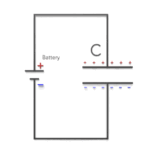RLC circuits, consisting of resistors (R), inductors (L), and capacitors (C), are fundamental building blocks in electrical and electronic systems. These circuits exhibit complex behavior due to the interaction of resistive, inductive, and capacitive elements. RLC circuits are used in various applications, including filters, oscillators, and transient response analysis.
RLC circuits can be classified into two types:
- Series RLC Circuit: The resistor, inductor, and capacitor are connected in series, and the total impedance (Z) of the circuit is the sum of the individual impedances.
- Parallel RLC Circuit: The resistor, inductor, and capacitor are connected in parallel, and the total admittance (Y) of the circuit is the sum of the individual admittances.
Resonance:
At a specific frequency called the resonant frequency (f_r), the reactive components of an RLC circuit balance each other out, resulting in either a purely resistive impedance (in a series RLC circuit) or a purely conductive admittance (in a parallel RLC circuit). The resonant frequency is determined by the values of the inductor and capacitor:
f_r = 1 / (2 * π * √(L * C))
Impedance and Admittance:
- Series RLC Circuit: Z = R + j(X_L – X_C) = R + j(ωL – 1/(ωC)), where ω = 2 * π * f
- Parallel RLC Circuit: Y = G + j(B_C – B_L) = 1/R + j(ωC – 1/(ωL)), where ω = 2 * π * f
Applications:
- Filters: RLC circuits can be used as low-pass, high-pass, band-pass, or band-stop filters, depending on the arrangement of the components and the output’s location. These filters selectively pass or attenuate specific frequency ranges, making them ideal for signal processing applications.
- Oscillators: RLC circuits can be combined with active components, such as transistors or operational amplifiers, to create oscillators that generate continuous, periodic waveforms. These oscillators are used in signal generation, frequency synthesis, and clock circuits.
- Transient Response Analysis: RLC circuits are often used to study the transient response of systems, including underdamped, overdamped, and critically damped behavior. Analyzing the transient response of an RLC circuit can help engineers understand the dynamics of more complex systems.
- Tuned Circuits: RLC circuits can be employed as tuned circuits in radio frequency (RF) applications, such as tuning and impedance matching in antenna systems, frequency selective circuits in receivers and transmitters, and in RF filters.
Understanding the behavior, equations, and applications of RLC circuits is crucial for designing and analyzing various electrical and electronic systems. These fundamental circuits are widely used in signal processing, communication, control, and power systems, making them an essential topic for engineers and technicians.
Example of Calculation
An RLC (Resistor-Inductor-Capacitor) circuit is an electrical circuit that consists of a resistor, an inductor, and a capacitor connected in series or parallel. In this example, we will consider a series RLC circuit connected to an AC voltage source and calculate the impedance, current, and voltages across the components at a specific frequency.
Given values:
- AC Voltage source (V_source): 20 Vrms (root-mean-square)
- Frequency (f): 50 Hz
- Resistor (R): 100 Ω
- Inductor (L): 200 mH (0.2 H)
- Capacitor (C): 20 µF (20 × 10^(-6) F)
- Calculate the inductive reactance (XL) and capacitive reactance (XC) at the given frequency:
XL = 2 * π * f * L XL = 2 * π * 50 Hz * 0.2 H ≈ 62.83 Ω
XC = 1 / (2 * π * f * C) XC = 1 / (2 * π * 50 Hz * 20 × 10^(-6) F) ≈ 159.15 Ω
- Calculate the total impedance (Z) of the RLC circuit:
Z = √(R^2 + (XL – XC)^2) Z = √(100 Ω^2 + (62.83 Ω – 159.15 Ω)^2) ≈ √(10000 + 9243.68) ≈ 142.34 Ω
- Calculate the current (I) through the circuit:
I = V_source / Z I = 20 Vrms / 142.34 Ω ≈ 0.141 A (rms)
- Calculate the voltage across the resistor (V_R), inductor (V_L), and capacitor (V_C):
V_R = I * R V_R = 0.141 A * 100 Ω ≈ 14.1 V (rms)
V_L = I * XL V_L = 0.141 A * 62.83 Ω ≈ 8.86 V (rms)
V_C = I * XC V_C = 0.141 A * 159.15 Ω ≈ 22.42 V (rms)
Note that the sum of the squared voltages across each component equals the squared source voltage due to the conservation of energy in the circuit:
(V_source)^2 = (V_R)^2 + (V_L)^2 + (V_C)^2 (20 V)^2 ≈ (14.1 V)^2 + (8.86 V)^2 + (22.42 V)^2
This example demonstrates how to calculate the impedance, current, and voltages across the components of a series RLC circuit connected to an AC voltage source at a specific frequency.



